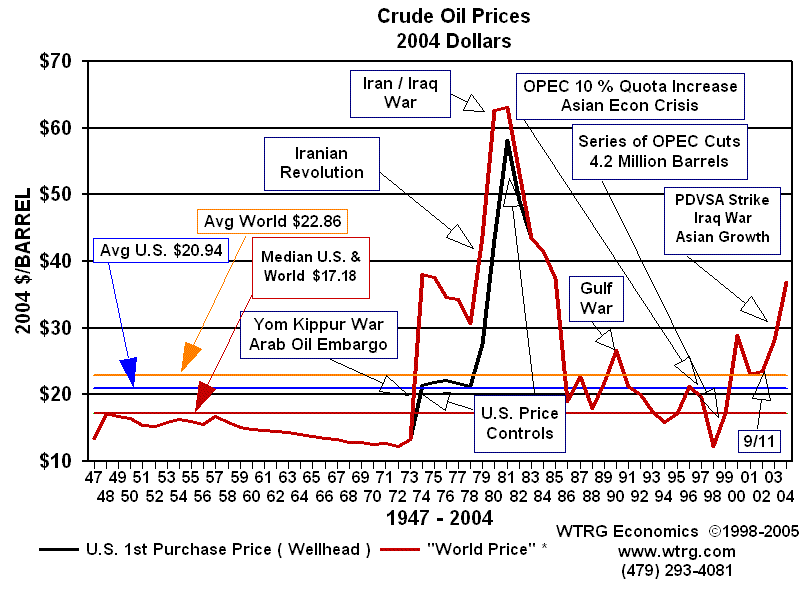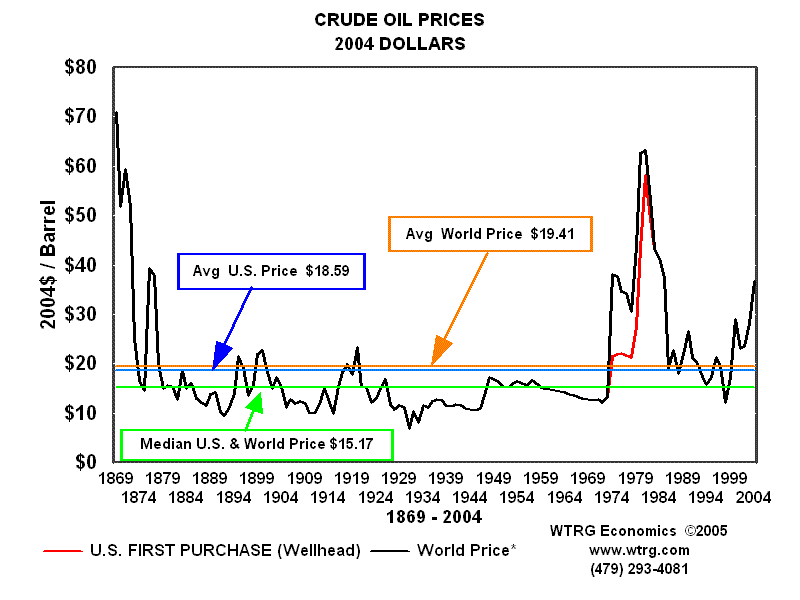In contrast, the worldwide average production cost for conventional oil is roughly $12/barrel.
 The problem is obvious - even at the lower cost-per-barrel Shell has reached, oil shale technology is only profitable in a world where oil prices are above $30 per barrel. Conventional oil will remain profitable even if the price tumbles below $30/barrel. That may be hard to contemplate in today's world of $70 a barrel oil, but as these graphs from WTRG Economics demonstrate, even counting the recent spike in oil prices the worldwide average for oil has stayed within the $20-25/barrel range for a century and a half.
The problem is obvious - even at the lower cost-per-barrel Shell has reached, oil shale technology is only profitable in a world where oil prices are above $30 per barrel. Conventional oil will remain profitable even if the price tumbles below $30/barrel. That may be hard to contemplate in today's world of $70 a barrel oil, but as these graphs from WTRG Economics demonstrate, even counting the recent spike in oil prices the worldwide average for oil has stayed within the $20-25/barrel range for a century and a half.
So while it may make economic sense to exploit oil shale right now, when oil prices are high, in the ten years it will take to truly ramp up to meaningful production levels the price of oil may drop. Worse, whatever the price of oil does in the next ten years, the very act of producing large amounts of oil from oil shale will drive the worldwide oil price down; flooding the market with oil produced from oil shale - and the proven oil shale reserves of the United States alone are three times the size of Saudi Arabia's conventional oil reserves, so production would flood the market - would drastically alter the supply and demand equation that has oil priced as high as it is right now.
In other words, there are significant economic reasons why oil shale is not and likely will not be a significant feature of the oil economy in the near future. As increased supply drove worldwide oil prices down, oil shale oil producers would tighten production (and, if necessary, cease production entirely) as it became less profitable. The result would be the U.S. getting far less strategic benefit from oil shale oil production than it might otherwise be able to.
Which is why I would propose government intervention in the market - or, more accurately, government activity in the market. The U.S. government should (and if I were President, would) guarantee all oil shale producers a profit margin of 6% on all oil shale produced in the U.S. at a cost of $30/barrel or less, up to a total of 7.5 billion barrels per year (the total U.S. oil consumption for 2004 according to the department of energy). The 6% figure is a slight drop from the average oil industry profit margin for the third quarter of 2005, which was 8.2% according to Gravmag. The drop in profit margin makes sense because of the absence of risk that the government guarantee would entail. To encourage continued reduction in production costs, I would propose a 50/50 split of any production cost decreases - that is, if production costs decline from $30/barrel to $29/barrel, the profit margin would be calculated as though the production costs had only dropped from $30/barrel to $29.50/barrel - and therefore the nominal 6% profit margin would actually be incrementally greater.
Lets talk dollars and cents for a second. At a production cost of $30/barrel, a 6% profit would be $2.10, or a total sale price of $32.10/barrel. If the market price for oil remained above $32.10/barrel, the guarantee would be irrelevant and the U.S. government would pay nothing. If the market price for oil dipped below $32.10/barrel, the U.S. would purchase the oil directly and then either use it, resell it on the market at market price, or add it to the Strategic Oil Reserve, as it chose. At most - that is if the oil shale producers produced the full 7.5 billion barrels and the market price of oil dipped to $0 - the program would cost $240B, or 1/10 of the 2005 U.S. budget. Assuming oil stabilizes at $10/barrel, that cost would drop to $165B, and at $20/barrel, the cost would be $95B. And, that money would: (1) be taxable by the government, allowing it to recover several billion dollars directly; (2) support a massive increase in the domestic economy, as oil shale production would provide jobs and other influxes of cash to the Wyoming, Colorado and Utah economies (which would, of course, be taxable); and - if worldwide oil prices stayed high until oil shale production came on line - (3) lower the cost of goods by driving down the cost of oil either as a resource in production (such as plastics) or an addition to the costs of transportation (in the form of high gas prices).
More importantly, those are primarily economic assessments. As I mentioned in the first post, the real impact of oil shale production would be geopolitical - stemming the flow of petrodollars to regimes such as Iran, Venezuela and Saudi Arabia, forever eliminating the threat of the "oil weapon" and dramatically reducing the influence of OPEC and its members on global policy issues. Looked at in that light, the funding for this initiative would be as much in America's national security interests as would any weapons development initiative put forward by the Pentagon.
No comments:
Post a Comment